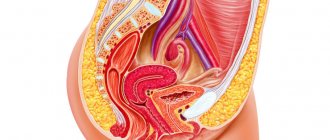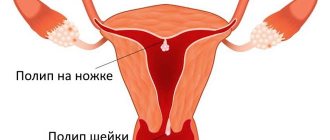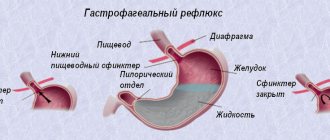- What is menopause and why do menstruation stop?
- Bleeding during menopause - is this normal?
- What causes metrorrhagia?
- Signs of uterine bleeding
- Necessary examinations
- Treatment
- How to stop uterine bleeding at home?
Menopause (menopause) is a natural condition in a woman, characterized by involution of sexual function with the extinction of the ovarian-menstrual cycle, hormonal changes in the body and the development of secondary somatovegetative symptoms.
The most important sign of this period is the gradual disappearance of menstruation. However, some women experience bleeding again during menopause, even to the point of developing uterine bleeding or metrorrhagia. This is a pathological condition and requires examination and treatment. How to stop uterine bleeding during menopause and what can cause it?
What is menopause and why do menstruation stop?
In medicine, menopause is referred to as “menopause.” This condition does not occur immediately; it is characterized by several successive stages: premenopause, menopause, perimenopause, postmenopause. The key event is the cessation of ovarian-regulated menstruation.
Menopause can be physiological, developing due to age. There is also an artificially created menopause, which occurs earlier and is iatrogenic. Its cause is severe suppression of ovarian function by medications, chemotherapy or radiation therapy, or removal of the ovaries.
Emergency care in a hospital setting
In case of severe hemorrhage, you should urgently consult a doctor or call an ambulance, as severe anemia or hemorrhagic shock will occur.
- First aid is to stop blood loss. If there is a suspicion of intrauterine pathology, then hysteroscopy and diagnostic curettage are performed.
- When a bleeding polyp is discovered, it is removed using resectoscopy, an endoscopic operation that involves removing the polyp through the cervix. In case of fibroids, as well as a number of other cases, they may resort to emergency removal of the uterus - hysterectomy.
- When organic causes that provoked the anomaly have not been identified, symptomatic therapy or hormonal hemostasis is performed. Elimination of extragenital pathology implies treatment of the underlying disease.
Bleeding during menopause - is this normal?
The resumption of bleeding from the genital tract after the cessation of menstrual function, as well as an increase in the volume of blood released during the premenopausal period, is an alarming symptom. When it appears, a woman should consult a doctor as soon as possible for examination and to identify the cause of the bleeding. Even scanty spotting is a reason to consult a gynecologist.
Menopausal uterine bleeding can be caused by local causes (related to pathology of the external or internal genital organs) and extragenital ones.
The latter include blood clotting disorders, systemic atherosclerosis with damage to the vessels of the atrophied endometrium, and uncontrolled arterial hypertension.
Local causes of uterine bleeding during menopause:
- malignant tumors of the body and cervix, endometrial cancer;
- benign neoplasms of the uterus that have undergone ulceration or necrosis (fibroids, polyps and endometrial hyperplasia);
- hormonally active (feminizing) ovarian tumors of various sizes, which can be represented by thecomas, granulosa cell neoplasms, arrhenoblastomas, cilioepithelial and pseudomucinous cystomas, Brenner tumor;
- ovarian tecomatosis - extensive proliferation of a special tectonic tissue, which is of mesodermal origin, has hormonal activity and is more related to the parenchyma;
- ovarian cancer;
- functioning of ovarian tissue even after the cessation of menstruation, with acyclic resumption of growth of the remaining follicles and defective functional changes in the endometrium.
There is also a less serious cause of bleeding during menopause - hormone replacement therapy for pathological menopausal syndrome. In some women, taking even small doses of hormones leads to menstrual-like or acyclic spotting from the genital tract.
Do not forget that spotting during menopause can be of more than just uterine origin. They are often caused by changes in the mucous membrane of the vulvovaginal area, and sometimes they are caused by bleeding from varicose veins of the vagina.
Features of menopause
A woman's body is designed in a special way. During reproductive age, a woman’s body and the functioning of some organs begin to undergo significant changes. They occur when exposed to organs that produce hormones. In these cases, bleeding from the vagina is considered an absolutely natural phenomenon. This process is called menstruation and includes one fifth of the entire cycle.
Before determining how to stop heavy periods during menopause, you need to talk about the very state of the woman’s body. When a woman is born, she already has a certain number of eggs in her body. By the time of puberty, this number may change. With each ovulation and subsequent menstrual cycle, such gametes begin to gradually be consumed, and there are fewer and fewer of them. During pregnancy, this process of reducing the number of eggs stops for a while, but with the restoration of the menstrual cycle it occurs again.
https://youtu.be/DS0h0Cq4X2w
Ovulation occurs when sex hormones are produced. The main ones in this case are estrogen, progesterone and luteinizing hormone. One is always replaced by the next. This is a completely natural process.
The moment the number of eggs becomes minimal, the menstruation process begins to stop. Ovulation no longer occurs and the ovaries stop working. This stage is called menopause. But even during this period of time, some women manage to conceive a child. Sometimes unexpected ovulation occurs and women are faced with the fact that the functioning of the ovaries does not completely disappear.
What causes metrorrhagia?
Uterine bleeding can occur without obvious provoking factors. But often, with a careful history taking, it is possible to identify a previous stressful situation, a hypertensive crisis, or heavy physical activity. Acute mental disorders, infectious diseases, and the use of hepatotoxic or blood thinning drugs are also possible. And in some patients, the onset of menorrhagia is triggered by sexual intercourse, increased intra-abdominal pressure with severe coughing, or straining due to constipation.
https://youtu.be/TR9j-A8_V6Y
Classification
Pathological uterine blood loss occurs both before and after menopause. The reasons that provoked them and the course of treatment mostly depend on the period of menopause.
There are 4 types of this phenomenon, which conditionally differ in the reasons that caused them:
- Associated with pathologies of the genital organs (uterus, endometrium, myometrium, ovaries, vagina);
- Due to hormonal imbalance, for example, dysfunctional uterine bleeding (DUB) before menopause;
- Iatrogenic. The reason is taking certain medications;
- Caused by extragenital pathology (disturbance of other systems: blood clotting, hypothyroidism, liver cirrhosis, etc.).
Signs of uterine bleeding during menopause
Uterine bleeding is difficult to miss. The uterine cavity communicates through the cervical canal with the vagina, this is a natural way for the removal of blood, mucus and other biological fluids. It is the appearance of bloody discharge from the genital tract with the appearance of characteristic marks on the underwear that becomes the reason for contacting a doctor.
The volume and rate of blood loss during uterine bleeding varies. With heavy discharge, clots appear; they are associated with intrauterine blood clotting. Sometimes bleeding appears suddenly, as if breaking through the cervix. Most often, this condition is observed after sexual intercourse if the patient has a hematometra (accumulation of blood in the uterine cavity).
Bleeding may be accompanied by pain in the lower abdomen or lower back of a pulling, cramping or aching nature. But often women do not notice obvious physical discomfort. There may be an increase in abdominal volume, bloating and a feeling of fullness. In some cases, there is discomfort during urination and defecation, which may be due to the effect of the existing tumor on neighboring organs, catarrhal pelvioperitonitis or swelling of surrounding tissues.
With repeated or heavy bleeding, a woman is often bothered by general weakness, fatigue, headaches, palpitations and shortness of breath with little physical exertion. This is associated with the development of posthemorrhagic iron deficiency anemia. In case of ovarian or uterine cancer, a persistent decrease in hemoglobin may also be due to intoxication. It is also possible to increase body temperature to subfebrile levels, deterioration of general condition, and fainting.
Uterine bleeding during menopause: what to do?
Before entering menopause, a woman’s menstruation is quite different in nature: it becomes more abundant, sometimes scantier, and the cycle also constantly varies. Sometimes periods disappear for quite a long period of time, but then return with normal regularity.
Cycle disruption is mainly associated with fluctuations in hormonal levels and a decrease in the frequency of ovulation. These two pathologies lead to the fact that the endometrium grows and menstruation becomes longer, and the interval of its appearance also changes. In medicine, these phenomena are considered quite natural for women in this period of life, so it is quite difficult to identify the disorder.
But there are some signs of abnormal uterine bleeding that indicate pathology and require you to visit a doctor:
- Intense discharge during menstruation (a standard pad or tampon needs to be changed every hour or two);
- There are a lot of blood clots in the discharge;
- There may be a slight discharge after sex;
- Bleeding between periods;
- The cycle length is less than 21 days;
- Menstruation lasts longer than 8 days;
- No periods for more than 3 months;
- Dizziness, fainting;
- Constant general weakness;
- Pale skin;
- Possible nausea and vomiting;
- Blood pressure is usually low.
Necessary examinations
A woman with menopausal bleeding should be carefully examined. In case of heavy bleeding, it is started simultaneously with treatment. And in mild cases, preference is given to the primary identification of the cause of metrorrhagia.
The examination program may include:
- gynecological examination (in speculum and bimanual method);
- aspiration of the contents of the uterine cavity and a smear from the cervix for subsequent oncocytological examination of the obtained material;
- study of the patient’s hormonal background with determination of the level of estrogen, progesterone, LH, FSH, 17-ketosteroids;
- Ultrasound using an abdominal and vaginal probe;
- if free fluid is detected in the pelvic cavity, puncture of the posterior fornix for oncocytological examination;
- general clinical examination with assessment of the blood coagulation system, liver function and identification of signs of anemia;
- study for tumor markers: CA 125, CA 199;
- therapeutic and diagnostic separate curettage of the uterine cavity and cervical canal;
- hysterosalpingography;
- hysteroscopy;
- MRI of the pelvic organs.
The scope of a comprehensive examination depends on the patient’s condition and gynecological examination data. Some invasive diagnostic procedures are performed only in a gynecological hospital.
Diagnostics
- Uterine bleeding that develops during menopause is a symptom of a fairly wide range of pathologies. In this regard, it is recommended to conduct a comprehensive diagnosis to identify and eliminate the causes. Initially, you need to visit a gynecologist or gynecologist-endocrinologist. The doctor will clarify the complaints, assess the patient’s general condition, ask her about chronic diseases and gynecological history, and also examine the results of the menogram.
- During a gynecological examination, it will be possible to establish the characteristics of the discharge, and sometimes its source. If at the time of examination there is no discharge at all, then a smear is performed to perform oncocytology.
- A transvaginal ultrasound (pelvic ultrasound with a vaginal sensor) is considered mandatory.
- The list of clinical tests includes tests for hormones, blood lipids and liver tests.
- The main method of diagnosis is diagnostic curettage. Tissues obtained as a result of the procedure are sent for histological examination. The procedure is performed under hysteroscopy control.
- Additionally, CT or MRI of the pelvic organs and hysterosalpinography can be performed. With their help, uterine polyps and fibroids of the intramural or submucosal type are detected.
Treatment of uterine bleeding
The basis for the treatment of metrorrhagia during menopause are drugs with a hemostatic effect. They can be prescribed by a doctor even before receiving the results of laboratory and instrumental studies; in fact, such hemostatic therapy is symptomatic. After identifying the cause of metrorrhagic syndrome, a decision is made on the tactics of further treatment of the patient.
The main hemostatic drugs for uterine bleeding during menopause:
- Aminocaproic acid, which inhibits the process of fibrinolysis;
- Icinon (Etamzilate) – reduces the permeability of vascular walls and activates the synthesis of thromboplastin;
- Vikasol is a synthetic water-soluble analogue of vitamin K, has a beneficial effect on the synthesis of proconvertin and prothrombin;
- Calcium gluconate – helps to seal the walls of small vessels and reduce their permeability.
Most often, Dicinon is used for uterine bleeding during menopause; it can be prescribed in the form of tablets or injections. The effect of its intramuscular administration occurs already by the end of the first 1.5 hours, and after intravenous infusion it can be expected within 15 minutes. Vikasol is not an emergency remedy; its effect on the hemostasis system manifests itself within 24 hours.
Oxytocin, a hormonal drug with uterotonic action, is also prescribed. The effect that occurs when using it is due to the mechanical compression of blood vessels during contraction of the walls of the uterus. Hormone replacement therapy can be prescribed for therapeutic and prophylactic purposes. Such tablets for uterine bleeding during menopause can partially correct the existing estrogen deficiency and mitigate the existing symptoms. When using them, you must strictly adhere to the dosage regimen, because a sharp drop in estrogen levels can provoke a new episode of metrorrhagia.
Based on the results of the examination, a decision may be made to surgically stop the bleeding. This may be curettage of the uterine cavity, removal of a bleeding polyp, enucleation of a nascent submucosal myomatous node, extirpation or amputation of the uterus. If signs of cancer and signs of ovarian damage are detected, an in-depth examination is prescribed to assess the stage of cancer, the presence of metastases and damage to neighboring organs. The scope of surgical intervention is determined individually.
Causes of pathology
- The main reason is hormonal imbalance. Impaired levels of sex hormones provoke the growth of the endometrium, resulting in symptoms such as heavy, prolonged and painful periods. Pathology often provokes the development of endometrial cancer. Hormonal imbalance can be caused by both natural age-related changes in the ovaries and chronic stress, excessive physical exertion, somatic diseases, and taking psychotropic medications.
- Uterine fibroids (benign tumor) are characterized by regular, prolonged and heavy menstruation, which occur due to impaired contractility of the uterine muscles. Tumor growth is usually observed before menopause, and immediately after it it stops.
- Pathology can be provoked by polyps and endometrial hyperplasia - proliferation of the lining of the uterus (inner). The disease can be without atypia or with it. In the latter case, the pathology is a precancerous condition.
- Bleeding between periods can be caused by a break in taking the pills. IUDs without hormones increase the volume of secretions, and with hormones they decrease.
- Polycystic ovary syndrome is characterized by endocrine disorders that stop ovulation. Therefore, menstruation appears very rarely (long, heavy) or is completely absent.
How to stop uterine bleeding at home?
Bleeding of moderate intensity, which does not lead to a significant deterioration in well-being, rarely causes an emergency visit to the doctor. Such patients usually resort to self-medication using alternative medicine methods.
But various folk remedies for uterine bleeding during menopause act only on the effect, without eliminating the root cause. In addition, they do not have as powerful and quick an effect as the medicine prescribed by the doctor. Therefore, their use is permissible only in agreement with the gynecologist as an addition to hemostatic drugs.
Typically, various herbal remedies are used in the form of decoctions or infusions, which have an indirect effect on the blood coagulation system and the tone of the uterine wall. This could be nettle, water pepper, viburnum bark, shepherd's purse, yarrow, horsetail and some other plants.
Self-medication of uterine bleeding is fraught with progression of the primary pathological process and can lead to late diagnosis of life-threatening gynecological diseases. In addition, some measures may even increase bleeding or cause complications, which significantly aggravates the woman's condition. That is why douching, inserting vaginal absorbent tampons, or applying a heating pad to the stomach are unacceptable.
Menopausal uterine bleeding is always a sign of some existing pathology and requires mandatory consultation with a doctor.
What can you do on your own?
It is worth remembering that if you suspect atypical uterine bleeding, you should not take a warm bath, apply a heating pad, douche, or use drugs aimed at contracting the uterus.
How can you stop uterine bleeding:
- Medications. The best option is to take it after consultation with a doctor. But if the condition noticeably worsens, then it is recommended: Vikasol (0.015 g 3 times a day), aminocaproic acid (30 ml up to 5 times a day), Dicinone (0.25 g 4 times a day), calcium gluconate (1 tablet 4 r/d). You can drink an infusion of water pepper or nettle, 100 ml three times a day;
- Cold. A heating pad with ice water or an ice pack wrapped in a towel is applied to the lower abdomen for 10-15 minutes, taking a 5-minute break between treatments. Manipulations are performed over one to two hours;
- Bed rest. It is advisable to place a pillow/cushion under your feet so that the majority of blood circulates through the vital organs of the body (brain, kidneys, etc.);
- Drink plenty of fluids. Along with the blood, the liquid is also washed away, so you need to drink sweet teas, maybe with rose hips, or at worst, water with sugar. The effect of glucose from drinks is aimed at nourishing the brain (nerve cells) and tissues of the whole body.
Necessary medical research
The following studies must be carried out simultaneously with treatment:
- A blood test is taken to study its biochemical composition and clotting characteristics.
- A blood test is performed to determine the level of hormones: LH, FSH, progesterone and estradiol. If thyroid pathology is suspected, then additionally test for TSH. For neoplasms in the ovaries - CA125 and CA199.
- A transvaginal ultrasound of the reproductive organs is performed.
- A smear is taken for oncocytology.
If there was surgery, then the endometrial tissue is examined. If necessary, the doctor may prescribe an MRI of the pelvic organs to the patient.
https://youtu.be/Y1dm_55TSY8
Treatment
Before starting treatment, it is necessary to identify not only the factors that provoked bleeding, but also to assess the amount of blood loss and the presence of impurities. To do this, diagnostics are carried out.
Diagnostic methods:
- blood test for hCG;
- blood test for tumor markers;
- cytological examination of smears;
- tomographic studies for suspected cancer;
- coagulogram;
- vaginal ultrasound examination of the pelvic organs;
- echohysterography;
- endometrial biopsy;
- color mapping using the Doppler method;
- hysteroscopy to examine hormonal levels;
- biochemical blood test.
Additionally, a woman may be referred for consultation to specialized specialists, for example, a hematologist or endocrinologist.
Any bleeding should be treated in a hospital setting. Experts use:
- Treatment using tablets - the causes and treatment of uterine bleeding are directly dependent on each other: by identifying and treating the underlying disease, you can get rid of life-threatening consequences forever.
- Transfusion is necessary to restore the volume of lost fluid, the number of red blood cells and platelets.
- Surgical methods are used only when the bleeding cannot be stopped with medications. Medical intervention takes place on a gynecological chair, using gynecological instruments. Administration of local or general anesthesia is allowed.
When is menstrual flow considered normal?
Menstruation is considered normal if it occurs at regular intervals, usually 21-35 days. And their duration ranges from 3 to 7 days. On the first day, the discharge may be darker in color and scanty. Usually only underwear gets dirty; a regular sanitary pad may be enough for a day.
The next 2-3 days the discharge is red (sometimes it can be pink due to a large amount of mucus), its volume varies between 60-80 ml per day. They may contain mucus and blood clots. Normal discharge has an odor similar to fresh meat.
Bleeding may worsen when performing strenuous physical work.
In recent days, the amount of discharge has been decreasing. They become darker. Panty liners may be enough for a day. There has been no discharge of mucus or blood clots for the first time or in recent days. During menstruation, blood loss is considered normal in the range of 200-300 ml. If there are deviations in any direction, there is a reason to visit a gynecologist.
What is menopause
In short, menopause is the age-related cessation of menstruation. This is a phase in the life of every woman when the reproductive function fades, the maturation of the follicle and the release of the egg stop. At this stage of her life, a woman is unable to become pregnant. Menopause begins at the age of 40-50 years and is accompanied by a number of unpleasant symptoms:
- hot flashes interspersed with chills;
- increased unconscious nervousness, fears, depression;
- sleep disorders;
- changes in blood pressure;
- the appearance of excess weight, especially in the abdominal area.
Menopause is preceded by perimenopause. This is a transitional state of the body when estrogen production decreases. Menstruation becomes unstable, and bleeding is either insufficient or heavy.
When estrogen production decreases, periods become irregular
Kinds
Gynecologists divide uterine bleeding into three categories:
- Bleeding is normal. In any of the woman’s cycles, menstruation occurs, which should be taken as the physiological norm for the female body.
- Conditionally normal . Discharge appears pre-ovulatory or post-ovulatory. Implantation blood loss also falls into the conditionally normal category of bleeding.
- Pathological. Such bleeding can appear at any age - during menopause, during childbearing age, and puberty. In turn, they are divided into subtypes: Functional - bleeding appears due to difficulties with the endocrine sphere or a disorder of the pituitary gland;
- Organic - when a woman is found to have formations (polyps and others) or diseases (for example, endometriosis), bleeding often occurs;
- Systemic - often caused by autoimmune diseases or chronic disorders.
Organic
They refer to diseases in which not only the production of hormones is disrupted, but also the surface of organs (tumors, cysts, polyps, pathological growth of the internal uterine layer, endometriosis, uterine oncology, and in addition cirrhosis of the liver, hematopoietic disorder).
Breakthrough
Breakthrough bleeding is caused by the use of hormone-modulating or birth control pills.
In 90% of episodes, if breakthrough blood loss occurs, the dosage of the drug is changed.
In addition, the uterus itself may bleed, in which there are violations of the integrity of the epithelium due to the uterine spiral.
In such a situation, withdrawal of the contraceptive is required.
Age
The most common causes of vaginal bleeding in the fairer sex differ depending on their age category.
Juvenile
Such an unhealthy deviation from the norms of menstruation appears due to a decrease in the presence of female hormones: estrogen, progesterone, androgen.
Bleeding is associated with dysfunction of the endocrine glands and reproductive organs.
Such bleeding is more typical for puberty girls, whose cycle is just starting to form, and for women belonging to the age group over 45 years.
The allocations are divided into:
- Anovulatory. They are aggravated by loss of strength, dizziness, and cycle disorders.
- Ovulatory. Directly related to the cycle, but red discharge is smeared or flows profusely without a break between menstruation. They are treated with hormonal drugs, returning the substances to normal.
The factors that cause the appearance of pathology before menstruation are:
- Formations on the reproductive organs.
- Bloody discharge during puberty from 8 to 16 years of age often occurs due to non-pathological dysfunction of glands and organs.
- Often occur in women as a seasonal pathology.
The main symptom is the lack of ovulation due to a hormonal disorder or interruptions in the endocrine system.
Other factors:
- loss of functionality of the ovaries, pituitary gland or hypothalamus;
- underformed smooth uterine muscles;
- arrhythmia of hormone synthesis;
- infectious diseases;
- stress and depression;
- strong intellectual or mental activity.
https://youtu.be/qTklinJC0v8
During pregnancy
If, after implantation of a fertilized egg to the wall of the uterus, a woman experiences any bleeding, this is a threatening condition for her health and life and for the preservation of the fetus.
If a woman notices significant bleeding, she should immediately call an ambulance.
Such bleeding is associated with the following manifestations:
- the appearance of significant pain in the lower abdomen, which is associated with contractions;
- nauseating feeling ending with vomiting;
- increased sweat production;
- the occurrence of dizziness;
- paleness of the skin.
Important! The appearance of bleeding during pregnancy is an extremely threatening symptom, essentially a threat to life for both the mother and her child.
After childbirth
Postpartum bleeding is normal. Normally, a woman has spotting blood discharge - lochia - for four weeks.
| Bleeding | Lochia |
| Heavy discharge Color scarlet, red The smell of blood In clots | Scarce Color rusty, brownish The smell is unpleasant No blood clots |
Bleeding after pregnancy and childbirth poses a risk to a woman's health.
Symptoms:
- Malaise
- Headache,
- Decreased pressure
- Pain in the lower abdomen
Bleeding and periods after abortion
When your period comes after an abortion and what its nature will be depends on how the abortion was performed and how the operation went. The patient’s immunity status and what her menstrual cycle was like before the procedure will also be affected.
The quality of a woman’s reproductive function, the presence of endocrine pathologies and the state of hormones in the body also have an impact.
Pilled abortion
It is normal if after this there is a discharge with small spots of blood for ten days. Usually your period comes as expected. But there are times when it may not come for 1-2 months, but then recover.
Vaum abortion
Bloody discharge can last from 10 to 15 days; it occurs due to trauma to blood vessels. Normal menstruation begins after 30-40 days, but there may be a delay of up to three months. The duration and intensity may vary, and periods may become painful.
Instrumental abortion
Menstruation after curettage occurs in 28-40 days. Two weeks after (especially in the first days), you can observe strong dark discharge in clots and even parts of the fetus. While the body is recovering, the volume of menstruation may fluctuate.
To prevent bleeding after termination of pregnancy, you need to avoid strength training in the first two weeks, do not drink coffee, do not eat chocolate, spicy food, avoid alcoholic beverages, and use the sauna. All this, as well as smoking, affects and increases blood circulation.
Bleeding after cauterization of erosion
A slight bleeding after cauterization indicates the healing process of the area where the manipulation was performed. Blood is considered normal and they talk about epithelial regeneration. You need to worry if they are very painful and abundant, or smell unpleasant.
During menopause
During menopause, a woman is at risk of developing formations of various etiologies (fibroids, polyps).
This is due to a decrease in the presence of estrogens, which are responsible for the menstrual cycle as a whole.
A distinctive feature of this period is the occurrence of pain at the time of sexual contact, and in addition, the gap between menstrual cycles exceeds a period of 3 months.
Prevention and folk remedies for menopausal bleeding
To prevent menopausal bleeding, gynecologists recommend folk remedies: taking a decoction of nettle, yarrow, shepherd's purse, infusion of orange peels, and peony tincture. It is also necessary to undergo regular medical examinations. examinations, correct chronic somatic pathology, perform ultrasound of the pelvic organs in the absence of gynecological pathology annually.
Anna Vladimirovna Sozinova, obstetrician-gynecologist
3, total, today
( 56 votes, average: 4.38 out of 5)
Recovery after caesarean section
Premenstrual syndrome - symptoms, causes, treatment
Related Posts
How is diagnostics carried out?
Uterine bleeding in menopause caused by disorders in the genitourinary organs is subject to a comprehensive examination by a gynecologist. First, a history is taken, that is, the doctor talks with the patient and finds out what symptoms accompany the bleeding. Then a bimanual examination is performed with a speculum of the walls of the vagina and uterus.
If necessary, the patient is sent for an ultrasound. An ultrasound examination will show the presence of fibroids, polyps, and other neoplasms. If the tumors cause concern to the doctor, a biopsy may be performed to determine oncology.
A laboratory blood test is required to check for iron deficiency anemia and hormonal ratios:
- estrogens;
- progesterone;
A blood test is required
- LH;
- FSH.
In the postmenopausal phase, or more precisely in old age, it is recommended to conduct an annual analysis for tumor markers, regardless of the presence of bleeding. And if they are available, even more often. As part of the examination, hysterosalpingography is performed.
Normal and abnormal bleeding during perimenopause
During premenopause, changes in hormonal levels can trigger the development of many dangerous diseases. Therefore, a woman should be attentive to the course of her periods and monitor all changes in the menstrual cycle.
It is advisable to keep a calendar of menstruation, in which you note not only the beginning, but also the end of bleeding, and also make notes about its intensity. This information will be very useful for the doctor to make a diagnosis.
Expert opinion
Alexandra Yurievna
General practitioner, associate professor, teacher of obstetrics, work experience 11 years.
If menstruation was absent for 2-3 months, and then resumed and is regular again, then doctors classify this situation as normal for the onset of menopause.
The following uterine bleeding in premenopause is considered abnormal:
- appeared immediately after sexual intercourse;
- very intense - one pad is not enough for 3 hours;
- contain large clots and parts of tissue;
- occur at short intervals - after 3 weeks and even more often;
- the duration of menstruation increases by 2-3 days;
- Between periods, spotting appears.
In all these cases, the woman must immediately contact a gynecologist in order to diagnose the pathology in time and begin treatment.
What bleeding during premenopause is pathological?
The presence of certain signs makes it possible to separate harmless discharge, which is present in almost all premenopausal women, from pathological ones. The presence of the following symptoms is considered an alarm signal:
- the secreted blood contains many clots or any foreign inclusions;
- a woman is forced to change the pad more often than once every three hours;
- spotting (especially heavy discharge) appeared immediately after sex;
- this symptom bothers a woman every three weeks or even more often;
- no bleeding for more than 3 months.
Blood clots during menopause
Diagnosis of vaginal bleeding after menopause?
The treatment prescribed by your doctor will depend on the causes of vaginal bleeding.
The doctor will begin searching for the cause of postmenopausal bleeding by asking the woman about the presence and nature of other symptoms. He may also ask about the following:
- when the woman first began to experience symptoms;
- how much blood is released from the vagina;
- Has anyone in her family experienced vaginal bleeding after menopause?
What is menopausal bleeding?
Menopausal bleeding is manifested by a sudden release of blood of varying intensity and the development of accompanying symptoms. It develops in such cases:
- With the development of menopause and prolonged absence of menstruation (more than 1 year). This indicates the presence of neoplasms and other pathological processes in the body.
- During premenopause, when menstruation still occurs, but irregularly and not heavily.
- In the presence of physical activity.
It is not difficult to distinguish menopausal bleeding from normal menstruation. They are characterized by such manifestations as:
- excessive bleeding, which requires changing the pad every hour;
- the appearance of blood clots;
- the addition of purulent threads and white inclusions that are not characteristic of menstruation;
- general decrease in performance;
- pale skin, dry mouth.
The development of bleeding is quite a dangerous phenomenon. In a short period of time, a woman can lose up to 350 ml of blood, which affects her health. Immediate medical attention is required. With self-medication, life-threatening conditions can develop, which in some cases provoke death.
What changes does the female body undergo with age?
The first age-related changes to which a woman’s reproductive system undergoes are observed already at 40-45 years of age. In some representatives of the fair sex this happens a little earlier or later, depending on hereditary factors, lifestyle and general health. Each woman experiences a gradual decline in reproductive function, which develops in several stages:
- premenopause. This period lasts for several years. With the onset of perimenopause, the nature of menstruation changes, they become irregular, heavy or, conversely, scanty. Menopausal bleeding during this period can be either a physiological process or provoked by certain pathologies;
- menopause. Occurs after the cessation of the last menstruation and lasts 1 year. At this time, the appearance of bleeding or even heavy discharge is considered an alarming signal. During menopause, the functioning of the ovaries almost ceases;
- postmenopause. Occurs when a year has passed since the last menstruation. At this time, the work of the woman’s reproductive system completely stops. Bleeding in postmenopause requires urgent medical intervention, since this condition is very dangerous and always indicates some kind of pathology.
https://youtu.be/IdbN3gIPQmU
What to do if blood appears during menopause?
There is only one way out for such discharge - visit a gynecologist. After the onset of menopause, even a completely healthy woman can develop a cancerous tumor, so examination is required.
First steps for bleeding
If a woman for some reason (queuing to see a doctor, work, other difficulties) cannot immediately go to the antenatal clinic, then first you need to remove the factors that provoke bleeding:
- Alcohol;
- Aspirin;
- Traditional medicine;
- Douching;
- Intimate relationships;
- Hormonal drugs;
- Physical activity - active sports, weight lifting, etc.;
- High temperatures - warming up, sauna, hot bath, exposure to the sun.
If you have hypertension, you need to control your blood pressure and take appropriate medications.
Diagnostics
At the clinic, the doctor will prescribe examinations that will help identify the cause of bloody vaginal discharge and rule out the presence of oncology:
- Inspection of the vagina and cervix for the presence of damage, erosion, polyps, condylomas, and atypical discharge.
- Vaginal smear to detect infections.
- A scraping from the cervix is sent for histology to check for the presence of atypical or cancerous cells.
- Ultrasound of the pelvic organs detects polyps, cysts, fibroids, inflammatory processes, tumors, and structural changes in tissue.
- A coagulogram determines blood clotting, errors in which can be an independent cause of bleeding.
- Analysis of the level of sex hormones in cases of suspected hormone-dependent diseases - fibroma or endometriosis.
- Blood tests for the presence of tumor markers make it possible to detect cancer when no other examination can detect it.
- MRI, if a tumor is detected, then its volume and the presence of metastases in the lymph nodes are checked.
- Hysteroscopy is prescribed to examine the uterus, remove polyps and take a biopsy.
Diagnosis of red or dark bloody discharge during menopause is primarily aimed at excluding oncology. Therefore, you need to prepare for a number of examinations and tests. And you shouldn’t hesitate, since symptoms appear already at the stage when the chances of healing decrease every day.
Treatment
The tactics for getting rid of bloody discharge will differ for different diseases. An individual approach is required, since many women during menopause have problems that should be taken into account when using medications or surgical methods, for example, diabetes, kidney or heart damage. We can only explain in general terms how to cope with diseases in such cases:
- For inflammatory infectious processes, antibiotics are prescribed in suppositories or tablets;
- For blood or vascular pathologies, drugs are used that strengthen capillaries or accelerate the clotting process;
- For endometriosis, curettage is performed and hormonal therapy is prescribed. As a rule, gestagens are used after menopause; in old age, male sex hormones can also be used;
- Polyps are removed using hysteroscopy;
- If the fibroid progresses, then a laparoscopic operation is performed, during which the blood supply to the formation is cut off. They also evaluate the endocrine causes of the pathology and, if necessary, eliminate them with medication;
- In case of injuries during sex due to vaginal dryness, hormones and artificial lubricants may be prescribed;
- If oncology is detected during menopause, the uterus and cervix are completely removed, and sometimes all genital organs, including the vagina.
Interesting fact! It happens that menopause occurs as early as 33-35 years old due to hereditary or pathological reasons. In this case, regular delays and brown discharge instead of menstruation may indicate the end of the childbearing period.
https://youtu.be/CUbJ5u5Wkfk
Common causes of bleeding
Experts note that often hospitalized women with uterine bleeding during menopause believe that it occurred without obvious provoking factors. But with a thorough survey, it is possible to quickly identify what reason provoked this process.
What are anovulatory MCs?
Therefore, we want to draw attention to the most common causes of bleeding during menopause:
- The occurrence of pathologies of the organs of the reproductive system. If there were no health problems before, it may be that they appeared with age. This reason always dominates over others during menopause. After all, the vagina, endometrium, cervix, and appendages can secrete blood. Therefore, first of all, doctors examine all genital organs to detect the source of blood discharge.
- Hormonal disorders. During premenopause, hormonal changes occur in the body of female representatives, which are manifested by jumps in the level of sex hormones. The organs of the reproductive system may react to such surges by bleeding.
- Taking certain medications. Women of mature age may have diseases that require constant use of certain medications. Blood thinners or hormonal medications may cause bleeding.
- Diseases that are not related to the reproductive system include bleeding among their symptoms. Below we will look at which diseases signal their development in this way.
- Severe stress. A stressful situation can provoke bleeding during menopause.
- Heavy physical activity. For an elderly person, serious physical activity is unacceptable. Mature women should reduce the load when playing sports or physical labor.
Thus, bleeding in a mature woman can occur for a variety of reasons. It is caused not only by problems with the genital organs. Therefore, ladies after 40 years of age need to be more attentive to their health.
Dependence of the nature of bleeding on the period of menopause
Each stage of menopause is characterized by certain etiological factors that cause bleeding.
| Menopause phase | Characteristics |
| Premenopause | The main cause of bleeding in the initial stages of ovarian involution is hormonal imbalance. Menstruation becomes irregular and may be absent for several months and then return. In some women they become less scanty, but more often the opposite is true. There may be a shortening of the menstrual cycle or the appearance of heavy, prolonged discharge during the intermenstrual period. |
| Postmenopause | If menstruation has been absent for more than 12 months, then the appearance of any type of bloody discharge (pink, red, brown) from the genitals should be considered, first of all, as a serious sign of a malignant neoplasm. This pathology is the most common cause of bleeding after menopause. Minor discharge can be caused by estrogen deficiency and thinning of the vaginal mucosa. They often occur or intensify after vaginal procedures (douching) or sexual contact, when additional trauma occurs. |
Vaginal cancer. Bleeding during menopause and cancer
Vaginal cancer is a fairly rare disease. The main factor influencing its occurrence is the woman’s age. A large number of women diagnosed with vaginal cancer are already 60 years of age or older.
The early stages of vaginal cancer are characterized by an asymptomatic course of the disease, but the more the cancer progresses, the sooner the woman begins to bleed. In addition, a woman may experience colorless, watery discharge or a feeling of uterine distension; the process of urination or defecation may also be accompanied by pain.
A specialist can easily detect vaginal cancer during a routine examination. In order to confirm the diagnosis of vaginal cancer, a specialist must perform a colposcopy and biopsy. The collected material is subjected to histological analysis, which confirms or excludes the presence of cancer cells in the vagina.
Therapy depends entirely on what type of cancer it is, what its stage of development is, what the woman’s age is and other factors. Generally, surgery, chemotherapy and radiotherapy are used as treatment.











